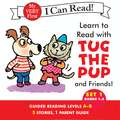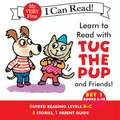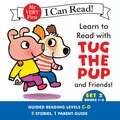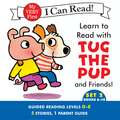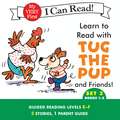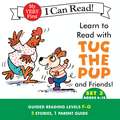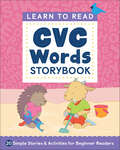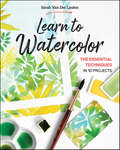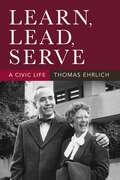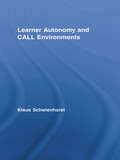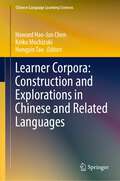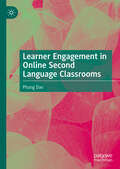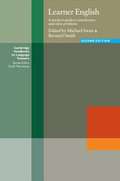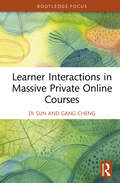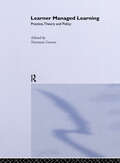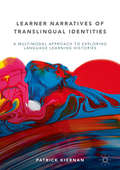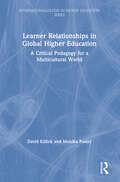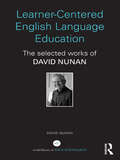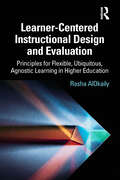- Table View
- List View
Learn to Program with Scratch: A Visual Introduction to Programming with Games, Art, Science, and Math
by Majed Marji<P>Scratch is a fun, free, beginner-friendly programming environment where you connect blocks of code to build programs. While most famously used to introduce kids to programming, Scratch can make computer science approachable for people of any age. Rather than type countless lines of code in a cryptic programming language, why not use colorful command blocks and cartoon sprites to create powerful scripts? <P>In Learn to Program with Scratch, author Majed Marji uses Scratch to explain the concepts essential to solving real-world programming problems. The labeled, color-coded blocks plainly show each logical step in a given script, and with a single click, you can even test any part of your script to check your logic. You'll learn how to: <br>–Harness the power of repeat loops and recursion <br>–Use if/else statements and logical operators to make decisions–Store data in variables and lists to use later in your program <br>–Read, store, and manipulate user input <br>–Implement key computer science algorithms like a linear search and bubble sort <br>Hands-on projects will challenge you to create an Ohm's law simulator, draw intricate patterns, program sprites to mimic line-following robots, create arcade-style games, and more! Each chapter is packed with detailed explanations, annotated illustrations, guided examples, lots of color, and plenty of exercises to help the lessons stick. Learn to Program with Scratch is the perfect place to start your computer science journey, painlessly.Uses Scratch 2
Learn to Read with Tug the Pup and Friends! Set 1: Books 1-5 (My Very First I Can Read)
by Dr. Julie WoodBuild your child's beginning reading success with this set of 5 simple and fun storybooks plus a separate parent guide!Written by educator and reading specialist Dr. Julie M. Wood, with lively illustrations by Sebastien Braun, this set of books stars Tug the Pup and an endearing group of characters who will lead beginners through the proven steps for successful reading.The Learn to Read with Tug the Pup books features sight word vocabulary, simple text, strong picture support, and character and plot development. The parent guide lists ideas for building early literacy skills through shared reading, games, and art activities. The 5 stories in this set are Guided Reading Levels A–B, which means it's the perfect entry point for new readers, with simple and predictable stories. Enter into the world of reading with My Very First I Can Read! This comprehensive emergent reading program addresses all the components of reading mastery based on the latest early literacy research.
Learn to Read with Tug the Pup and Friends! Set 1: Books 6-10 (My Very First I Can Read)
by Dr. Julie WoodBuild your child's beginning reading success with this set of 5 simple and fun storybooks plus a separate parent guide!Written by educator and reading specialist Dr. Julie M. Wood, with lively illustrations by Sebastien Braun, this set of books stars Tug the Pup and an endearing group of characters who will lead beginners through the proven steps for successful reading.The Learn to Read with Tug the Pup books features sight word vocabulary, simple text, strong picture support, and character and plot development. The parent guide lists ideas for building early literacy skills through shared reading, games, and art activities. The 5 stories in this set are Guided Reading Levels B-C, which means it's the perfect entry point for new readers, with simple and predictable stories.Enter into the world of reading with My Very First I Can Read! This comprehensive emergent reading program addresses all the components of reading mastery based on the latest early literacy research.
Learn to Read with Tug the Pup and Friends! Set 2: Books 1-5 (My Very First I Can Read)
by Dr. Julie WoodBuild your child's beginning reading success with this set of 5 simple and fun storybooks plus a separate parent guide!Written by educator and reading specialist Dr. Julie M. Wood, with lively illustrations by Sebastien Braun, this set of books stars Tug the Pup and an endearing group of characters who will lead beginners through the proven steps for successful reading.The Learn to Read with Tug the Pup books features sight word vocabulary, simple text, strong picture support, and character and plot development. The parent guide lists ideas for building early literacy skills through shared reading, games, and art activities. The 5 stories in this set are Guided Reading Levels C–D, which means the stories are still very simple but include dialogue and are slightly more advanced than the A and B level stories.Enter into the world of reading with My Very First I Can Read! This comprehensive emergent reading program addresses all the components of reading mastery based on the latest early literacy research.
Learn to Read with Tug the Pup and Friends! Set 2: Books 6-10 (My Very First I Can Read)
by Dr. Julie WoodBuild your child's beginning reading success with this set of 5 simple and fun storybooks plus a separate parent guide!Written by educator and reading specialist Dr. Julie M. Wood, with lively illustrations by Sebastien Braun, this set of books stars Tug the Pup and an endearing group of characters who will lead beginners through the proven steps for successful reading.The Learn to Read with Tug the Pup books features sight word vocabulary, simple text, strong picture support, and character and plot development. The parent guide lists ideas for building early literacy skills through shared reading, games, and art activities. The 5 stories in this set are Guided Reading Levels C–E, which means the stories are still very simple but include dialogue and are slightly more advanced than the A and B level stories.Enter into the world of reading with My Very First I Can Read! This comprehensive emergent reading program addresses all the components of reading mastery based on the latest early literacy research.
Learn to Read with Tug the Pup and Friends! Set 3: Books 1-5 (My Very First I Can Read)
by Dr. Julie WoodBuild your child's beginning reading success with this set of 5 simple and fun storybooks plus a separate parent guide!Written by educator and reading specialist Dr. Julie M. Wood, with lively illustrations by Sebastien Braun, this set of books stars Tug the Pup and an endearing group of characters who will lead beginners through the proven steps for successful reading.The Learn to Read with Tug the Pup books features sight word vocabulary, simple text, strong picture support, and character and plot development. The parent guide lists ideas for building early literacy skills through shared reading, games, and art activities. The 5 stories in this set are Guided Reading Levels E–F, which means the vocabulary, sentence structure, and plots are still simple, but richer than sets one and two.Enter into the world of reading with My Very First I Can Read! This comprehensive emergent reading program addresses all the components of reading mastery based on the latest early literacy research.
Learn to Read with Tug the Pup and Friends! Set 3: Books 6-10 (My Very First I Can Read)
by Dr. Julie WoodBuild your child's beginning reading success with this set of 5 simple and fun storybooks plus a separate parent guide!Written by educator and reading specialist Dr. Julie M. Wood, with lively illustrations by Sebastien Braun, this set of books stars Tug the Pup and an endearing group of characters who will lead beginners through the proven steps for successful reading.The Learn to Read with Tug the Pup books features sight word vocabulary, simple text, strong picture support, and character and plot development. The parent guide lists ideas for building early literacy skills through shared reading, games, and art activities. The 5 stories in this set are Guided Reading Levels F-G, which means the vocabulary, sentence structure, and plots are still simple, but richer than sets one and two.Enter into the world of reading with My Very First I Can Read! This comprehensive emergent reading program addresses all the components of reading mastery based on the latest early literacy research.
Learn to Read: 20 Simple Stories & Activities for Beginner Readers (Learn to Read)
by Crystal RadkeTeach kids their CVC words with illustrated stories—for ages 3 to 5 CVC words are three-letter words made up of a consonant-vowel-consonant combination—like "cat" and "big"—that are essential for beginning readers as they learn to blend letter sounds. Encourage your preschool or kindergarten reader to practice their CVC words with the Learn to Read: CVC Words Storybook! Inside, they'll find 20 simple stories that each focus on two common CVC words, along with fun activities that put these new words and skills into action. Learning to read has never been so fun!Hold their attention—These stories are fun and engaging for preschool and kindergarten kids with bright colors, adorable pictures, and simple language.Read, play, and learn—Let your child practice what they've learned with quick reading games and activities at the end of each story that encourage them to read, trace, circle, and color CVC words.Watch their skills grow—Introduce CVC words gradually, with stories that slowly increase in complexity as your child works their way through the book.Get this CVC book today and make it fun for early readers to learn new skills through the science of reading!
Learn to Read: 25 Simple Stories & Activities for Beginner Readers (Learn to Read)
by Kimberly Ann KiedrowskiHelp kids ages 3 to 5 start reading with simple stories and sight words.Encourage your little one to read with 50 essential sight words. From "up" and "down" to "could" and "it," these simple illustrated stories are the perfect summer activities to help early readers recognize words in sentences and understand their meaning. There's even a pair of fun activities after every story to further reinforce what they've learned! It's the perfect summer workbook to keep kids engaged in learning.Get your young reader learning sight words with the science of reading:25 stories—Sight words are introduced gradually, with each story increasing slightly in difficulty. As a summer learning workbook, it reinforces what children learn and keeps them interested as they prepare for preschool and kindergarten.Common sight words—Give your child a solid foundation for reading with top sight words like "many," "time," "go," "out," "do," and "know."Educational activities—At the end of each story you'll find two fun reading games where your child can practice identifying the words they've just read, reinforcing the learning.Discover fun preschool and kindergarten learning activities with this top choice in learn-to-read books for kids 3-5.
Learn to Teach
by Catherine ScottLearn to Teach explores the most up-to-date findings on how children learn, to help teachers create effective learning environments and plan for teaching. Drawing on a neo-Vygotskian approach to learning, it covers the purpose of education; socio-cultural approaches to human cognition; attention and intelligence as cognitive tools; and the role of mindsets, memory and language in learning. It promotes the idea that the mind is a cultural product and that education is best understood as fostering the development of valued cognitive tools appropriate for the 21st century. To provide readers with a holistic understanding of learning, the book explores the significant contributions to the study of learning and teaching from psychologists, sociologists and cultural theorists. Readers are encouraged to critically engage with - and challenge - some of the prevailing learning theories in order to better understand their students. Each chapter features classroom observation exercises, discussion questions and links to further reading.
Learn to Think: Basic Exercises in the Core Thinking Skills for Ages 6-11
by John LangrehrClassroom questions have traditionally focussed on testing the recall, understanding and application of content and methods. Research suggests that pupils require activities that encourage them to think flexibly about possibilities and to make independent judgements about information. Learn to Think takes a cross-curriculum approach and offers a wide range of exercises in all significant thinking skills areas: Organisational Analytical Evaluative Creative Predicting, categorisation, ordering, generalising, problem solving, summarising, analysis, making distinctions, decision making, cause and evidence are among the skills developed. This book introduces the basic core thinking processes used to connect and make sense of information through a range of skill based sections which provide the basis of a thinking skills programme for pupils. It is complete with introductory notes and examples, pupil work sheets, suggested answers and further useful questions. The resources are fully photocopiable and are suitable for 6 -11 year olds.
Learn to Watercolor: The Essential Techniques in 10 Projects
by Sarah Van Der LindenLearn to watercolor paint in 10 easy steps! Get inspired with gentle and serene watercolor painting as your next calming hobby. Learn the foundational skills of watercolor painting with various techniques that will leave you feeling confident in your skills. The watercolors explained in this book achieve two essential objectives: to immediately enjoy painting and acquiring a solid foundation. Master the basics through 10 gorgeous watercolor projects. With each project, you will learn one to three new techniques. Your confidence and inspiration will grow with each stroke of the brush! Learn the foundational skills of watercolor painting while completing 10 easy display-worthy projects Master these basic techniques: painting a perfect gradient, controlling the fusion of colors, playing with the wetness of the paper, creating various textures, and more Paint plants and flowers with watercolors using this easy step-by-step visual guide
Learn, Lead, Serve: A Civic Life
by Thomas EhrlichThomas Ehrlich served in the federal administrations of six presidents, beginning with Kennedy in 1962. He was also Dean of Stanford Law School, Provost of the University of Pennsylvania, President of Indiana University, and one of the pioneers of the service-learning movement. Weaving together memorable family stories and valuable professional insights, Ehrlich tells how he developed the knowledge and skills to be a leader in both government and higher education, the lessons he learned in those roles, and the many ways he and his wife Ellen balanced family life and civic service along the way. Warmly written and brimming with fascinating, behind-the-scenes details, Learn, Lead, Serve is both a celebration of an accomplished career and an inspiring lodestar for those wanting to follow the path of public service.
Learner Autonomy and CALL Environments (Routledge Studies in Computer Assisted Language Learning #Vol. 3)
by Klaus SchwienhorstThis volume brings together two prominent strands in second language acquisition theory and research: the concept of learner autonomy and computer-assisted language learning (CALL). Learner autonomy supports learners in becoming more reflective and communicative and in experimenting with language and language learning. CALL environments offer more and qualitatively different opportunities for learner autonomy than the traditional language classroom. This book offers researchers a starting point into researching learner autonomy in CALL contexts and offers teachers practical advice on chances and pitfalls in realizing learner autonomy goals in the CALL-supported classroom.
Learner Choice, Learner Voice: A Teacher’s Guide to Promoting Agency in the Classroom
by Ian Jukes Ryan L Schaaf Becky ZayasLearner Choice, Learner Voice offers fresh, forward-thinking supports for teachers creating an empowered, student-centered classroom. Learner agency is a major topic in today’s schools, but what does it mean in practice, and how do these practices give students skills and opportunities they will need to thrive as citizens, parents, and workers in our ever-shifting climate? Showcasing authentic activities and classrooms, this book is full of diverse instructional experiences that will motivate your students to take an agile, adaptable role in their own learning. This wealth of pedagogical ideas – from specific to open-ended, low-tech to digital, self-expressive to collaborative, creative to critical – will help you discover the transformative effects of providing students with ownership, agency, and choice in their learning journeys.
Learner Corpora: Construction and Explorations in Chinese and Related Languages (Chinese Language Learning Sciences)
by Hongyin Tao Howard Hao-Jan Chen Keiko MochizukiThis edited book reflects the state of the art in learner corpus and related approaches to Chinese as a second language (CSL). CSL as a field has flourished in the past few decades due to the increasingly important role of the Chinese language at the world stage, yet studies of Chinese as a second language based on learner corpora have been less well developed due to the limited availability of data and lack of theoretical insights. This book represents the latest research in this area by 1) assembling a large group of active researchers from multiple international research communities (USA, China, Hong Kong, Macau, Japan, Taiwan, and France); 2) discussing the latest resources and technologies in Chinese and other Asian languages learner corpora and corpus building; 3) basing Chinese as a second language studies on data from learners of Chinese with a wide range of first language backgrounds (English, Japanese, Korean, French, among others); and 4) integrating corpus methods with a wide range of related methods in allied fields—language acquisition, usage-based linguistics, psycholinguistics, and neurolinguistics. This comprehensive collection is indispensable for anyone who is interested in corpus approaches to CSL and Chinese applied language studies in general.
Learner Engagement in Online Second Language Classrooms
by Phung DaoThis book explores current research on online instructed L2 acquisition, with a specific focus on the nature and impact of learner engagement in online L2 classroom interaction. It examines the topic of online learner engagement from various theoretical perspectives, discusses conceptual and methodological issues, synthesizes research on the role of learner engagement in online L2 classroom interaction, and critically assesses its connection to teaching practices across different L2 settings. The book is intended for a wide audience, including undergraduate and postgraduate Applied Linguistics, TESOL and Second Language Education students seeking to understand the significance of learner engagement in online L2 learning. It will also be useful for researchers interested in staying updated on recent findings regarding the benefits of learner engagement in online classroom interaction for L2 learning. Additionally, teachers, teacher trainers and educators in Teacher Education (TE) and/or continuous professional development (CPD) programs can benefit from the pedagogical insights offered in this book regarding online L2 instruction in various contexts.
Learner English: A Teacher's Guide to Interference and Other Problems
by Michael Swan Bernard SmithThis updated edition is a practical reference guide which compares the relevant features of a student's own language with English, helping teachers to predict and understand the problems their students have. Learner English has chapters focusing on major problems of pronunciation, grammar, vocabulary and other errors as well as new chapters covering Korean, Malay/Indonesian and Polish language backgrounds.
Learner Interactions in Massive Private Online Courses
by Gang Cheng Di SunBy employing learning analytics methodology and big data in Learning Management Systems (LMSs), this volume conducts data-driven research to identify and compare learner interaction patterns in Massive Private Online Courses (MPOCs). The uncertainties about the temporal and sequential patterns of online interaction, and the lack of specific knowledge and methods to investigate details of LMSs' dynamic interaction traces have affected the improvement of online learning effectiveness. While most research focuses on Massive Open Online Courses (MOOCs), little is investigating the learners’ interaction behaviors in MPOCs. This book attempts to fill in the gaps by including research in the past decades, big data in education presenting micro-level interaction traces, analytics-based learner interaction in massive private open courses, and a case study. Aiming to bring greater efficiency and deeper engagement to individual learners, instructors, and administrators, the title provides a reference to those who need to evaluate their learning and teaching strategies in online learning. It will be particularly useful to students and researchers in the field of Education.
Learner Managed Learning: Practice, Theory and Policy
by Norman GravesA collection of essays presenting the many issues and themes related to self-directed learning, which uses case studies and references to demonstrate that the learner-directed approach is a key ingredient for organizational and personal growth and development.
Learner Narratives of Translingual Identities: A Multimodal Approach to Exploring Language Learning Histories
by Patrick KiernanThis book addresses translingual identities through an innovative multimodal analysis of the language learning histories of a class of advanced learners of English in Japan who grew up between two or more languages. The author explores both the translingual experiences of those in the classroom and how they use language and gesture when describing their experiences to each other. This approach uses three perspectives: it looks at the worlds and identities the interviewees construct for themselves; at their interpersonal communication; and at the way they frame their experience. Finally, it offers some lessons based on the observations of the class which reveal the values they share and the key to their success as language learners. It will appeal to applied linguistic and educational researchers, particularly those with an interest in narrative approaches to exploring educational contexts, as well as language educators and policy makers interested in gaining a learner perspective on language learning.
Learner Relationships in Global Higher Education: A Critical Pedagogy for a Multicultural World (Internationalization in Higher Education Series)
by David Killick Monika FosterProviding the academic community with a robust and highly practical insight into the importance of implementing relationship building into the learning environment and experiences of all students, underpinned by current research, this innovative volume explores intercultural learning and critical pedagogy in the borderless university. By revealing cutting-edge theoretical perspectives and practice which can facilitate critical connections between diverse students, their learning, curriculum, each other, and their communities, Learner Relationships in Global Higher Education integrates academic and student perspectives on relationship development into academic practice. Drawing upon case studies and examples of good practice from across the globe, this book illustrates how practitioners in diverse contexts are designing student experiences in face-to-face and online contexts on- and off-campus to advance learner relationships. By situating this work in a critical pedagogy perspective, the book advances internationalisation in and for a global and multicultural world. In the changing contexts of global higher education, this book is a valuable tool for higher education researchers and practitioners at all stages of their careers.
Learner-Centered English Language Education: The Selected Works of David Nunan
by David NunanThis carefully crafted collection provides a snapshot of the evolution of David Nunan‘s theoretical and empirical contributions to the field of second language education over the last 40 years. The volume focuses on the development of his work on second language curricula, and in particular, the work for which he is best known: learner-centered education and task-based learning and teaching. David Nunan has been a language teacher, researcher and consultant for 40 years. He has lived and worked in many countries, principally in the Asia-Pacific region, but also in the Americas, Europe and the Middle-East. In addition to his research and scholarly work, he is the author of several major textbook series for the teaching and learning of English as a foreign Language. These texts are based on his task-based language teaching approach, and are widely used in schools, school systems and universities around the world.
Learner-Centered Instructional Design and Evaluation: Principles for Flexible, Ubiquitous, Agnostic Learning in Higher Education
by Rasha AlOkailyLearner-Centered Instructional Design and Evaluation offers a forward-thinking, evidence-based vision of technology-enhanced higher education that taps into today’s digital access opportunities for more dynamic, agnostic, and inclusive learning experiences. The recent ubiquity of digital devices has fostered a new generation of learners who are technologically adept, engage in rapid social co-construction of knowledge, and expect increased choice and personalisation of educational content and environment. Colleges and universities, however, continue to apply their technology tools into outdated, passive pedagogies. Based on theory and empirical research, this book’s innovative framework guides scholars and practitioners toward instructional design and evaluation approaches that leverage the anytime-anywhere potential of wireless networked devices to foster flexible learning experiences and device-neutral assignments. Each chapter is rich with designs, deliveries, and evaluations of lesson plans, projects, and other real-world course works exemplifying the procedures and principles that will rejuvenate learning amid the globalisation, commodification, and massification of higher education.

